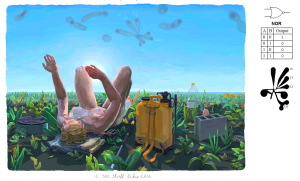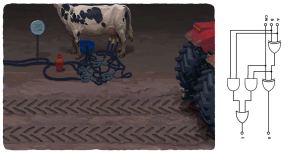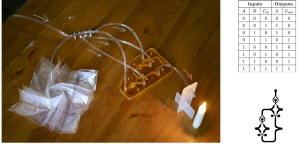
NOR // silhouette of a fluidic logic gate and its truth table, digital painting, lightbox, 2024
I am happy to teach computer history at a fine arts university. Besides, I also work with small kids. Part of my job is to pry phones out of their hands—not the most pleasant part of the day. This is partly because (as with every mandatory intervention) it stirs up more chaos than it prevents. Still, the phones really make the kids crazy. Behavioral modification and adaptive algorithms make us crazy–that’s their job after all.
People get deranged and depressed when they are told that they are not needed. When they feel that laws, state orders and and machines run their lives and their futures, or their humanity is reduced to an interplay between social and biological programs. And while we’re chipping away at real human agency, there’s a parallel admiration for (or a fear of) digital technology. Many people tend to call large language models “AI”, artificial intelligence, and as an extension to that, they see the future as the time of technocratic omnipotence, the coming era of untethered artificial minds. Artists and intellectuals often eat this up, because they are kinda lazy and naive—they want to seem forward-thinking or avoid looking outdated. Well, maybe it’s not that simple. As Jeffrey Kripal and Jacques Derrida would point out, the humanities have always been haunted by apparitions, prophecies, and mystical machines.1
Why do we conflate “computation” and “intelligence”? I’m no AI or sociology expert, but I have a few guesses. These aren’t exactly original ideas, and I’ll start with the boring ones. But first, let’s set aside the common belief that living beings are indeed machines, byproducts of genetic and social programs—a view so widely accepted that even a 13-year-old could tell you. They also tell you that God is dead and hell awaits us all. That might turn out to be true, but for now, let’s choose another angle.
1. AI as Marketing Scam: The idea of AI and the Singularity is a marketing tool for selling half-baked products or attracting money from investors, governments, and even military projects. This hype goes back to the cybernetic think tanks after WWII.2
2. Old-School Technocratic Thinking: We’ve always tried to model the human mind through whatever effective tech is in vogue: with the steam engine, we get the categories of Freudian psychology (the whole pneumatic theatre play of the libido and the various forces restricting, masking, or channeling it), and the factory-model of the mind. With cybernetics and computers, we get information processes, computational models, functionalism, and cognitivitism. Very neat abstractions and knowledge fields based on shaky metaphors.
3. Secular Mysticism: AI hype can also be seen as a secular twist on mystical ideas, especially from Abrahamic religions, where divine truths (and universal laws) are “out there”, external to the world. They are not intuitive or immanent—they are revealed through sacred or coded language. We could get more mystical with our programs: instead of vessels of the Apocalypse, we should treat them as oracles, like we did with Tarot or the Zairja.3 When people like Leibniz and Boole were inventing binary systems and formal logic (the foundations for our digital age), they felt lifted up, closer to divine order. So maybe AI is just an echo of that same drive to find something beyond ourselves. It’s a shadow of a radically neutral, elevated reality.
4. Environment as Mind: AI is a variation of an even older experience through a Cartesian lens. Some thinkers view cognition as extending beyond the individual mind, with the surrounding environment playing an active role. A spider’s web, for example, may be part of its mind.4 We think with and by our surroundings, by our fellow creatures, routines and objects. With our songs, machines, works of art, and so on. Technology is not just an extension of us, neither a self-sustaining organism or a noosphere. Paradoxically, when we speak of the coming Singularity or artificial general intelligence, we may overlook the actual, integrative nature of technology. We could do better than that. We can be less dualistic about agency and thought. We can work without strict separations between the body and the mind, hardware and software, nature or culture. Computational models and human agency don’t have to compete in a zero-sum game.5
This is the starting point of my work and why I’m drawn to computational design that moves beyond black-box thinking. We should be modeling human activity and computation without fixating on code, rigid laws, or scripted languages. Interestingly, engineers and theorists can’t really agree on what “computation” means. Most often, they define it as information processing, describing computers as machines or networks that manipulate symbols. Other professionals are looking for a solution in automation theory and problem-solving.
Here is my take: a base level for any computation is a goal-oriented, non-random process. Or better yet, computation is about bringing together things that rely on future events, adjusting to changes in the environment. Things that change their shape or mediate change in a dynamic medium. Objects that can be efficiently described temporally. Animal traps and pollinating flowers share this nature. Along these lines we can connect natural and cultural events within the field of goal-oriented behavior. Seeking a goal, planning beforehand, these should be human things, right? We make plans by constructing mental representations in our head. But how plants and animals do it? Do they use mental representations? What is the ideal form of a beaver dam? Or nest-building birds—are they platonic about branches?
Living beings are maintained (and created) by several levels of goal-driven phenomena, some internal, some external. We can also change our environment so
that new situations and things can occur, which in turn will change our customs, and on a longer timescale, our physical form. Our environment can solve things for us. Our environment can kill or mutate us. This is the kind of computational design I’m interested in—design that draws on external processes, things that unfold on their own, often in dynamic settings like air or water.6

Full udder // plan of a full adder logic circuit, digital painting, lightbox, 2023
While we are familiar with computational systems that use sophisticated software to add new functions to already existing products and environments, enriching our experience by recontextualization (smart watches, smart homes, VR and AR applications, dating apps) we rarely think of objects, buildings or art projects as computation. The most common form of algorithmic design is a finite length command (usually written in a programming language, mediated by a specific program) which is applied at the start of a process, generating new effects and responses without the constant intervention of a human being. With the diverse use of procedural and generative programs in gaming and architecture computation is getting everywhere, albeit it works through a network of symbols: a language or an abstract calculation. Within a program a highly formalized code dictates the dynamics of the relationships that certain part of an object or a symbolic unit maintains with its surroundings. Just as with the Cartesian distinction between mind and body, our computational techniques heavily rely on separating hardware from software. This top-down collaboration between agents is not exclusive to information technology. Recipes, user manuals and avant-garde concepts also operate on representations, a widely applicable instruction or a command, which is distinct from any particular interaction (from, say, a description, a collision or an exchange of data, a handshake or a threat), and a step-by-step approach to generate partial results towards achieving a goal. Funnily enough, our current systems are not always like that: neural nets are bottom-up structures.7
Could we reformalize computation without relying too heavily on symbols and codes? Well, several tasks that would require the programming of some piece of hardware can be outsourced to so called natural processes (as in contrast to cultural ones, like writing down a prescription or doing math), such as plant growth, phase changes in certain materials, flexibility of a body part, or motion of a medium. A beaver dam or a maple seed, for instance, responds to future events based on certain natural conditions. These work like “if-then” conditionals without needing a specific number value, a string of symbols, or a precisely set threshold. Fluidics—an alternative form of computation—uses fluids or air flow as a dynamic medium to accomplish tasks, much like how plants pollinate through the air. Stepping from single-purpose machines to general-purpose ones, the standard procedure is to emulate circuit elements in order to build a digital system: mostly (but not exclusively) Boolean logic gates to structure and evaluate energy or material flow through a space of possible routes or phases. 8 From marble counting to reaction-diffusion wave fronts digital computers can be built in various environments. Fluidics was a promising field of computer engineering during the sixties, on both of the sides of the iron curtain.9 As proof of concept, a pure fluid computer was built in the USA. 10 Pumping pressurized air through 250 NOR gates FLODAC used the same operational architecture as its electric counterparts. In theory, it could do everything that your computer can do. Just more slowly. But not if it’s connected to other passive systems.

A handmade full adder circuit and its truth table. The blue lines mark the flow of air in this small computational system, the blue ones are the input, the pink ones are the output channels. By manipulating the three input channels, you can let pressurized air into the logic circuit (input=1) or leave the channel closed (input=0). The logic circuit is in the middle.

A handmade full adder circuit from AND, XOR , and OR gates.
Although pure fluid computers can’t reach the arithmetic capacity of modern electric models, their low manufacturing cost and energy consumption, the lack of moving parts, and the way they capitalize on parallel channels of activity to evade the von Neumann bottleneck made them a cheap and versatile toolkit for numerous tasks. Microfluidics became a multidisciplinary field, mainly used in labs for molecular analysis and in the development of wearable, non-electric diagnostic systems. Logic-enabled textiles can react to changing weather conditions in order to help their wearer. 11 A drainage system integrating logic functions can offer a model for reactive architectural design by using non-invasive technology.12 By eliminating a mediating level of abstract semiotics, embodied logic also serves as an educational tool for students interested in computation. As a common ground for low-tech goal-oriented planning, it can connect multiple fields, from object design to architecture or experimental music. By removing elemental computation from its informatics context, naked logic helps us to rediscover the shared life world between nature and culture, between human beings and their environment. Finally, we could see the layered nature of a computer. We can see it as a collection of things, languages and practices, as a tool to see other things differently, and a way to create new objects and thoughts (or to destroy them).
We won’t be able to separate computation from metaphysical speculation and creepy, colonizing projects. Any new idea or approach will end up in a deeply chaotic place, muddled by manipulation and craziness. But, as Jaron Lanier reminds us all the time, striving for ultimate purity, a hunt for a universal solution is what lead us there.

Boldizsár Hordós (1991) earned his master’s degree from the Hungarian University of Fine Arts in 2016. He is currently a PhD student at the same institution and teaches computer history in the Intermedia Department.
Notes:
1 Kripal, Jeffrey J. (2019). The Flip: Epiphanies of Mind and the Future of Knowledge.
Bellevue Literary Press, New York.
2 Dupuy, J. (2009). On the Origins of Cognitive Science: The Mechanization of Mind. MIT
Press.
3 Sam Kriss has a witty essay about ancient AI: https://samkriss.substack.com/p/a-users-guide-to-the-zairja-of-the.
4 Japyassú, H.F., Laland, K.N. Extended spider cognition. Anim Cogn 20, 375–395 (2017).
https://doi.org/10.1007/s10071-017-1069-7.
5 You don’t have to be a marxist to see that we still make machinery by alienating the work
and creativity of various creatures from the creatures themselves. True technocrats know this
dirty secret, but they are not crazy, they won’t talk about it.
6 Adamatzky, A. (2019). A brief history of liquid computers. Philosophical Transactions of the
Royal Society B, 374(1774), 20180372. https://doi.org/10.1098/rstb.2018.0372
7 Copeland, B.J., Methods and goals in AI, .https://www.britannica.com/technology/artificial-intelligence/Methods-and-goals-in-AI
8 Adamatzky, A. (2021). Handbook of Unconventional Computing. WORLD SCIENTIFIC
eBooks. https://doi.org/10.1142/12232
9 Auger Raymond, N., Pneumatic Computer Research in the USSR, Automatic control, Vol.
13, No. 6 (December 1960), pp. 43-48.
10 Gluskin, R. S., Jacoby, M., & Reader, T. D. (1964). FLODAC – a pure fluid digital computer.
Managing Requirements Knowledge, International Workshop On, 1, 631.
https://doi.org/10.1109/afips.1964.74
11 Rajappan, A., Jumet, B., Shveda, R. A., Decker, C. J., Liu, Z., Yap, T. F., . . . Preston, D. J.
(2022). Logic-enabled textiles. Proceedings of the National Academy of Sciences of the
United States of America, 119(35). https://doi.org/10.1073/pnas.2202118119
12 Carlström, C.H.V., Architecture as elemental computer,
https://royaldanishacademy.com/project/architecture-elemental-computer

